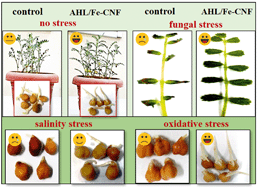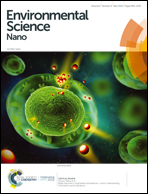Bacterial homoserine lactones as a nanocomposite fertilizer and defense regulator for chickpeas†
Abstract
Recent advances in agro-nanotechnology have made it possible to deliver bioactive chemicals to plants. In the present study, magnetic carbon nanofibers (Fe-CNFs, 75 μg mL−1) were used for the delivery of acylated homoserine lactones (AHLs, 0.171 and 1.71 mg L−1) in chickpea (Cicer arietinum) plants to enhance growth as well as stress tolerance. The negative zeta potential (−22 mV) at the Fe-CNF surface supported the binding of oppositely charged AHL molecules and facilitated their translocation in the plants. Seeds grown under exposure to the AHL (10 μM or 1.71 mg L−1)/Fe-CNF nanocomposite (NC) for 3 days showed a significant (p < 0.01) improvement in the germination index (GI = 13 ± 2) and vigor index (VI = 257.5 ± 2) with respect to the control (GI, 6 ± 1 and VI, 78 ± 10) and individual AHL exposure (GI, 7 ± 1 and VI, 120 ± 12). Seeds incubated with NC showed normal germination rates under simulated oxidative (5 mM H2O2) and salinity (200 mM NaCl) stresses, whereas germination rates decreased under identical conditions without NC. At a later stage of the plant life cycle, the plants treated with the NCs prepared with 0.171 and 1.71 mg L−1 (1 and 10 μM, respectively) AHL every third day until 30 days showed a significant increase of Fe in their roots (7.14 mg g−1), shoot (4.27 mg g−1) and leaves (4.33 mg g−1) with respect to the control (3.53, 1.28 and 2.38 mg g−1, respectively), indicating that NCs were effectively translocated from roots to shoot. The exposure to NC prepared with 10 μM (1.71 mg L−1) AHL resulted in increased plant biomass (6.1 ± 1.2) as well as total chlorophyll (64.6 ± 8 μg mL−1) and protein (5.4 ± 0.6 mg g−1) contents with respect to the control (3.8 ± 0.8; 56.7 ± 6 and 3.7 ± 0.4, respectively). The NC-exposed plants also showed resistance to infection by the Fusarium oxysporum f. sp. ciceri fungal pathogen. The present study developed a novel bioactive nanomaterial that serves in a dual role: a fertilizer and a defense regulator for plants.



 Please wait while we load your content...
Please wait while we load your content...